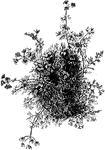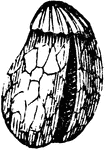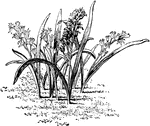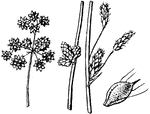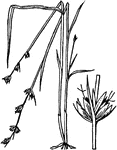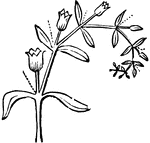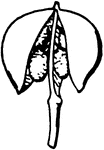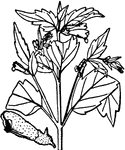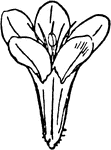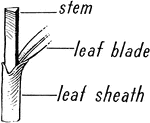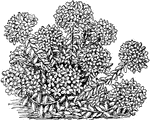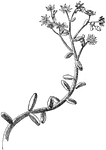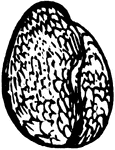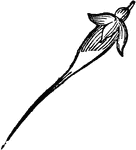437 illustrations of flowers and shrubs including: sabatia, safflower, saffron, sage, sainfoin, saltbush, sassafras, saururus, saxifrage, sedge, sesame, shad scale, shamrock, shooting star, skullcap, sloe, snakeroot, snapdragon, sneezeweed, snowberry, soapwort, sorrel, spurge, squash, St. John's wort, star of Bethlehem, starflower, stonecrop, strawberry, sumac, sundew, sundrops, and sunflower

Sauvagesia
"Lavradia Vellozii. 1. an expanded flower; 2. the stamens with exterior petaloid scales; 3. a seed;…

Summer Savory
The Summer Savory (Satureja hortensis) is a flowering plant of the Lamiaceae family. The image shows…
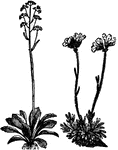
Saxifrage
An extensive genus of hardy perennial herbs, with alternate leaves and simple flower-stems. They are…
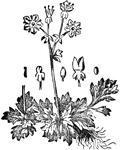
Saxifrage
"A genus of plants of the natural order Saxifrangeae. This order has a calyx, usually of five sepals…
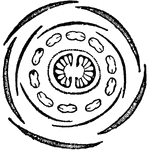
Saxifrage
"Diagram of the flower of Saxifrage (Saxifraga tridactylites). The calyx and corolla consist of five…

Early Saxifrage
Of the saxifrage family (Saxifragaceae), the early saxifrage or Saxifraga Virginiensis.

Early Saxifrage
"Flowering plant of saxifrage (Saxifraga virginiensis). a, a flower; b, the fruit." -Whitney, 1911

False Mitrewort and Naked Mitrewort
Of the saxifrage family (Saxifragaceae): left, false mitrewort (Tiarella cordifolia); right, naked mitrewort…

Golden Saxifrage
Of the saxifrage family (Saxifragaceae), the golden saxifrage or Chrysosplenium americanum.

Grass of Parnassus
Of the saxifrage family (Saxifragaceae), the Grass of Parnassus or Parnassia caroliniana.

Sweet Scabious
"Scabiosa atropurpurea. 1. a flower; 2. the involucre opened to show the ovary and calyx; 3. perpendicular…
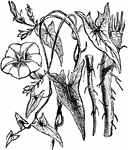
Scammony
The scammony (Convolvulus scammonia) is a flowering plant of the bindweed family. R, the root.

Begnia Glaucophylla Scandens
"This is a drooping or creeping species, with light green, glossy leaves and large clusters of orange…
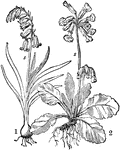
Scapes
A scape is a flowering, leafless stem; shown here on two different plants. "1. Wild hyacinth (Scilla…

Scarlet Plume
Scarlet plume is the common name of euphorbia fulgens. The plant is native to Mexico. It is a small…
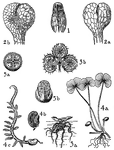
Schizaeaceae, Osmundaceae, Salviniaceae, and Marrsileaceae
Schizaeaceae: 1, aneimia, sporangium. Osmundaceae: 2, Osmunda, sporangium; a, front view, b, back view.…

Schubertia
"Schubertia multiflora. 1. the anthers united to the stigma; 2. the ovary and stigma, from the latter…
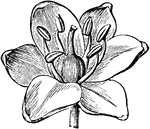
Scilla
Scilla (squill) is a genus of bulb-forming perennial herbs in the Hyacinthaceae. The 90-odd species…
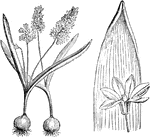
Puschkinia Scilloides
A white flower with stripes of blue down the center. It typically blooms in the Spring, and is found…

Scouring Rush
"A scouring-rush (Equisetum sylvaticum). At the right is a colorless fertile stem, in the middle a green…

Sea lavender
"Sea lavender (statice limonium) is a native British plant, being fairly common in certain…

Fox Sedge and Fringed Sedge
3, The Fox Sedge (Carex vulpinoidea) and 4, the Fringed Sedge (Carex crinita).

Sedum
Sedum is the large stonecrop genus of the Crassulaceae, representing about 400 species of leaf succulents,…

Sedum Leaf
"Leaf of a live-forever (Sedum sp.), with a portion of the epidermis peeled back. Underneath the epidermis…
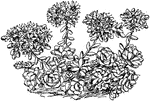
Spathulifolium Sedum
This plant belongs to the sedum, featuring high water retention, great for filtering air pollutants.
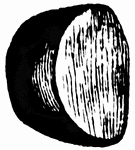
Seed-coat
The outer coat is sometimes close and even, and fitted to the kernel, as in this Morning-glory, (Gray,…

Seed-coat
The outer coat is extended into a thin border or wing as in this Trumpet Creeper, (Gray, 1858).


